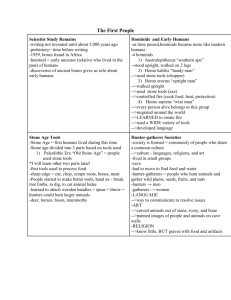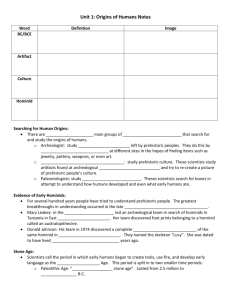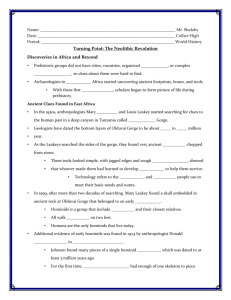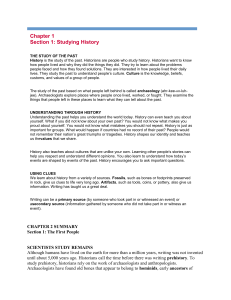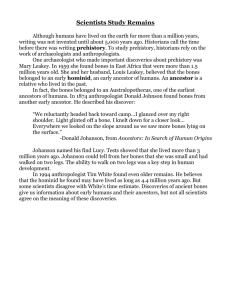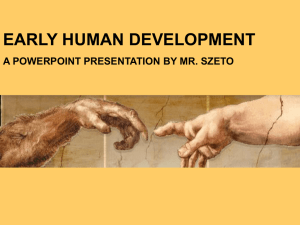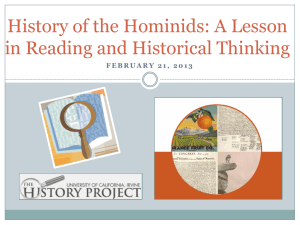this paper - Genealogy of Religion
advertisement
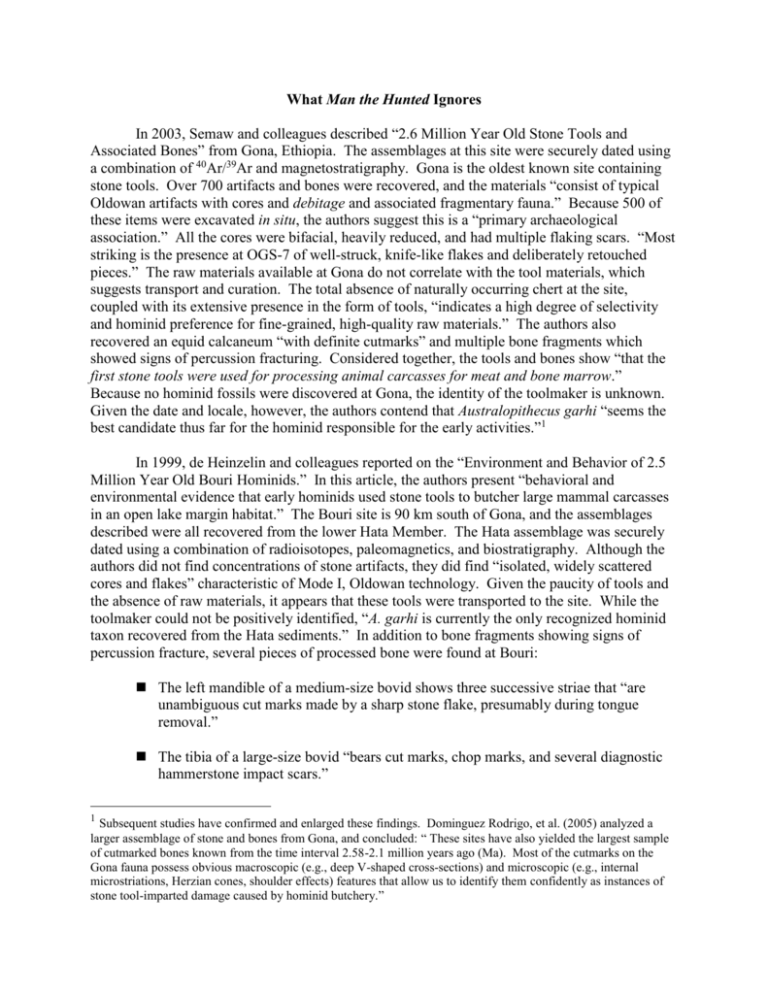
What Man the Hunted Ignores In 2003, Semaw and colleagues described “2.6 Million Year Old Stone Tools and Associated Bones” from Gona, Ethiopia. The assemblages at this site were securely dated using a combination of 40Ar/39Ar and magnetostratigraphy. Gona is the oldest known site containing stone tools. Over 700 artifacts and bones were recovered, and the materials “consist of typical Oldowan artifacts with cores and debitage and associated fragmentary fauna.” Because 500 of these items were excavated in situ, the authors suggest this is a “primary archaeological association.” All the cores were bifacial, heavily reduced, and had multiple flaking scars. “Most striking is the presence at OGS-7 of well-struck, knife-like flakes and deliberately retouched pieces.” The raw materials available at Gona do not correlate with the tool materials, which suggests transport and curation. The total absence of naturally occurring chert at the site, coupled with its extensive presence in the form of tools, “indicates a high degree of selectivity and hominid preference for fine-grained, high-quality raw materials.” The authors also recovered an equid calcaneum “with definite cutmarks” and multiple bone fragments which showed signs of percussion fracturing. Considered together, the tools and bones show “that the first stone tools were used for processing animal carcasses for meat and bone marrow.” Because no hominid fossils were discovered at Gona, the identity of the toolmaker is unknown. Given the date and locale, however, the authors contend that Australopithecus garhi “seems the best candidate thus far for the hominid responsible for the early activities.”1 In 1999, de Heinzelin and colleagues reported on the “Environment and Behavior of 2.5 Million Year Old Bouri Hominids.” In this article, the authors present “behavioral and environmental evidence that early hominids used stone tools to butcher large mammal carcasses in an open lake margin habitat.” The Bouri site is 90 km south of Gona, and the assemblages described were all recovered from the lower Hata Member. The Hata assemblage was securely dated using a combination of radioisotopes, paleomagnetics, and biostratigraphy. Although the authors did not find concentrations of stone artifacts, they did find “isolated, widely scattered cores and flakes” characteristic of Mode I, Oldowan technology. Given the paucity of tools and the absence of raw materials, it appears that these tools were transported to the site. While the toolmaker could not be positively identified, “A. garhi is currently the only recognized hominid taxon recovered from the Hata sediments.” In addition to bone fragments showing signs of percussion fracture, several pieces of processed bone were found at Bouri: The left mandible of a medium-size bovid shows three successive striae that “are unambiguous cut marks made by a sharp stone flake, presumably during tongue removal.” The tibia of a large-size bovid “bears cut marks, chop marks, and several diagnostic hammerstone impact scars.” 1 Subsequent studies have confirmed and enlarged these findings. Dominguez Rodrigo, et al. (2005) analyzed a larger assemblage of stone and bones from Gona, and concluded: “ These sites have also yielded the largest sample of cutmarked bones known from the time interval 2.58-2.1 million years ago (Ma). Most of the cutmarks on the Gona fauna possess obvious macroscopic (e.g., deep V-shaped cross-sections) and microscopic (e.g., internal microstriations, Herzian cones, shoulder effects) features that allow us to identify them confidently as instances of stone tool-imparted damage caused by hominid butchery.” The femur of a three-toed horse (Hipparion) “bears stone-tool cut marks indicative of dismemberment and filleting.” The“stone-wielding hominids” at Bouri, the authors contend, were consuming meat: “The bone modifications indicate that large mammals were disarticulated and defleshed and that their long bones were broken open, presumably to extract marrow, a new food in hominid evolution with important physiological, evolutionary, and behavioral effects.” In conclusion, the authors note additional research is necessary to determine “whether the butchery is related to hunting or scavenging,” and the Bouri assemblage demonstrates “that a major function of the earliest known tools was meat and marrow processing of large carcasses.” Henry Bunn, for his part, has published approximately 20 articles and 2 books on the subject of hominid meat/marrow consumption. Though it was difficult to decide on any one article, I finally chose his 1986 study – “Systematic Butchery by Plio-Pleistocene Hominids at Olduvai Gorge, Tanzania” – because it includes Comments and a Reply. In this article, Bunn reports on the FLK Zinjanthropus “site” (which actually consists of several sites in close proximity). FLK-Z has been dated to approximately 1.75 million years ago and contains 60,000 bone specimens. The majority of these fragments are unidentifiable, and the taphonomy surrounding them unclear. Of these 60,000 specimens, 3,500 are identifiable as distinct skeletal parts belonging to “larger” mammalian taxa. Using the most conservative criteria for identifying “cut marks” (i.e., those criteria which critics such as Potts, Shipman, and Binford accept as definitive), 172 of these specimens exhibit cut marks.2 Thus, of the 3,500 identifiable bones, approximately 5% have cut marks, all of which are consistent with the use of stone tools for defleshing and disarticulating. Many of these bones (and others) show signs of percussion fracturing, which is consistent with “extensive hammerstone breakage of marrow bones.” Curiously, Bunn does not discuss the number or kinds of tools, though one gets the sense it is a low-density in terms of manufactured lithics (giving rise to the suggestion that stones/bones were transported to these sites). Interestingly, Mora and Torre (2005) analyzed the lithics from the FLK Zinjanthropus assemblage and found that unworked percussion hammerstones (which show signs of use) were the dominant tools, and had been unfairly neglected in previous studies. Bunn does, however, analyze bone frequencies and finds that limb bones are overrepresented and axial bones are underrepresented (again suggesting transport). Bunn concludes by observing that “early hominids at Olduvai were butchering carcasses by an efficient and systematic technique that involved skinning, dismemberment, and defleshing operations.” A remarkable array of heavy-hitters commented on Bunn’s article, including (among others) Stanley Ambrose, Kay Behrensmeyer, Lewis Binford, Robert Blumenschine, Richard Klein, and Henry McHenry. Richard Potts (1987) commented in a subsequent and separate entry. Everyone agreed with Bunn’s basic claim: approximately 1.75 years ago at Olduvai, hominids were using stone tools to access meat and marrow. The arguments revolved around how the hominids acquired the bones, whether carnivores or hominids accessed the meat first, 2 Bunn does not agree with these stringent criteria and contends that an additional 340 specimens are cut marked. For purposes of his analysis, however, he excludes these from consideration. 2 and what role meat/marrow played in these hominids’ diet. Bunn was in favor of hunting (with considerable meat consumption) and scavenging; Blumenschine argued for active scavenging (with minimal meat and much marrow consumption); Binford advocated passive scavenging (with mostly marrow consumption). Potts, after questioning the frequency of bones exhibiting cut marks, agreed on the “fundamental point” made by Bunn: “Hominids of Bed I at Olduvai did evidently acquire meat through butchery and were not restricted to eating marrow from bones. In addition, skeletal-part data and other considerations suggests that hominids both scavenged and hunted.” CONCLUSION There is a truly massive literature on hominids and their use of stone tools to access animal meat/marrow. Clearly, hominids were not vegetarians and it is specious to contend they were. Hominids began acquiring and consuming meat/marrow at least 2. 6 million years ago (and presumably earlier, given the sophistication of the Gona tools). As we move forward in time, these activities increase in sophistication, scale and scope. There are numerous indications of hominid hunting/scavenging behavior over the last one million years in particular. Virtually no one doubts that archaic Homo sapiens and Homo neanderthalensis were devoting considerable amounts of time and energy to the acquisition of animal proteins. Indeed, it is interesting to note that Curtis Marean – whom Hart and Sussman (p.75) so admire for his work suggesting that “early” hominids merely scavenged the kills of saber-toothed cats – has published extensively on more recent hominids. In response to Binford’s lonely contention that Neanderthals (and early modern humans) were merely scavenging, Marean (1998) reassessed all the sites Binford used for his analysis and stated: “[T]he assemblages are then analyzed in their entirety and a new pattern, consistent with hunting, is revealed. . . . The conclusion is that there is no reliable evidence for scavenging by Neandertals or early modern humans.” It should be noted, however, that neither this conclusion nor the huge body of evidence regarding animal protein acquisition-consumption force us into an untenable dichotomy. We need not, in other words, find that hominids were aggressive, bloodthirsty killers whose entire focus was on hunting. As Ungar, Grine and Teaford (2006) recently observed in a comprehensive review of diet for early Homo, a more inclusive hypothesis suggests itself: The fossil, archeological, and paleoenvironmental evidence taken together suggest a model of increasing dietary versatility with the appearance and early evolution of Homo. Perhaps then, early Homo, and especially H. erectus, had an adaptive strategy of dietary versatility. This versatility would have been advantageous in an unpredictable, changing environment or an environment dominated by many different microhabitats. Perhaps H. erectus was the first hominin to leave Africa because it was the first with sufficient dietary versatility to allow it to do so. Evidence of an important role for meat eating is more compelling for H. erectus. Large concentrations of stone tools and modified bones after 1.9 Myr combined with thinner enamel may suggest improved abilities to slice and shear tough foods, including meat. A higher incidence of small pits in the enamel may indicate the consumption of soft, tough foods such as meat (Teaford & Runestad 1992). 3 However, did meat dominate their diets? Not necessarily. The little lithic microwear evidence we have suggests that early Pleistocene tools were used to process animal and plant tissues (Keeley & Toth 1981). Hart and Sussman, in their zeal to debunk an osteodontokeratic caricature that died with Raymond Dart and Robert Ardrey, have ignored hundreds if not thousands of studies on hominid tool-use and meat/marrow consumption. Umbrella hypotheses – unless they are driven by ideology – do not require this kind of omission. Rather, such hypotheses purport to explain apparently non-conforming data or better explain the available data. Hart and Sussman’s “man the hunted” hypothesis does not attempt to do either. It simply ignores everything that does not fit. This would include the stone tool cut marks on the Stw 53c (late A. africanus/early Homo) maxilla, which Pickering, White, and Toth (2000) assert is “the earliest unambiguous evidence that hominids disarticulated the remains of one another,” and the stone tool cut marks on the 600,000 year old Bodo cranium (White 1986) indicative of defleshing. Human ancestors were not simply vegetable eating prey animals – they were opportunistic predators not only of other animals but also of other hominids. REFERENCES CITED Bunn, Henry and Knoll, Ellen. 1986. “Systematic Butchery by Plio-Pleistocene Hominids at Olduvai Gorge, Tanzania. With Comments and Reply.” Current Anthropology, 27(5):431-452. Dominguez-Rodrigo, M. , Pickering, T., Semaw, S., Rogers, M. 2005. “Cutmarked bones from Pliocene archaeological sites at Gona, Afar, Ethiopia: implications for the function of the world’s oldest stone tools.” Journal of Human Evolution, 48:109-121. Heinzlein, Jean, et al. 1999. “Environment and Behavior of 2.5 Million Year Old Bouri Hominids.” Science, 284:625-629. Marean, Curtis. 1998. “A critique of the evidence for scavenging by Neandertals and early modern humans: new data from Kobeh Cave (Zagros Mountains, Iran) and Die Kelders Cave 1 Layer 10 (South Africa).” Journal of Human Evolution, 35(2):111-136. Mora, Rafael and de la Torre, Ignacio. 2005. “Percussion tools in Olduvai Beds I and II (Tanzania): Implications for early human activities.” Journal of Anthropological Archaeology, 24:179-192. Pickering, et al. 2000. “Cutmarks on a Plio-Pleistocene Hominid from Sterkfontein, South Africa.” American J. of Phys. Anthropology, 111:579-584. Potts, Richard. 1987. “On Butchery by Olduvai Hominids.” Current Anthropology, 28(1):9598. 4 Semaw, Sileshi, et al. 2003. “2.6 Million year old stone tools and associated bones from OGS-6 and OGS-7, Gona, Afar, Ethiopia.” Journal of Human Evolution, 45:169-177. Ungar, Peter, Grine, Frederick, and Teaford, Mark. 2006. “Diet in Early Homo: A Review of the Evidence and a New Model of Adaptive Versatility.” Annual Review of Anthropology, 35:209–28. White, Timothy. 1986. “Cut Marks on the Bodo Cranium: A Case of Prehistoric Defleshing.” American J. of Phys. Anthropology, 69:503-509. 5
